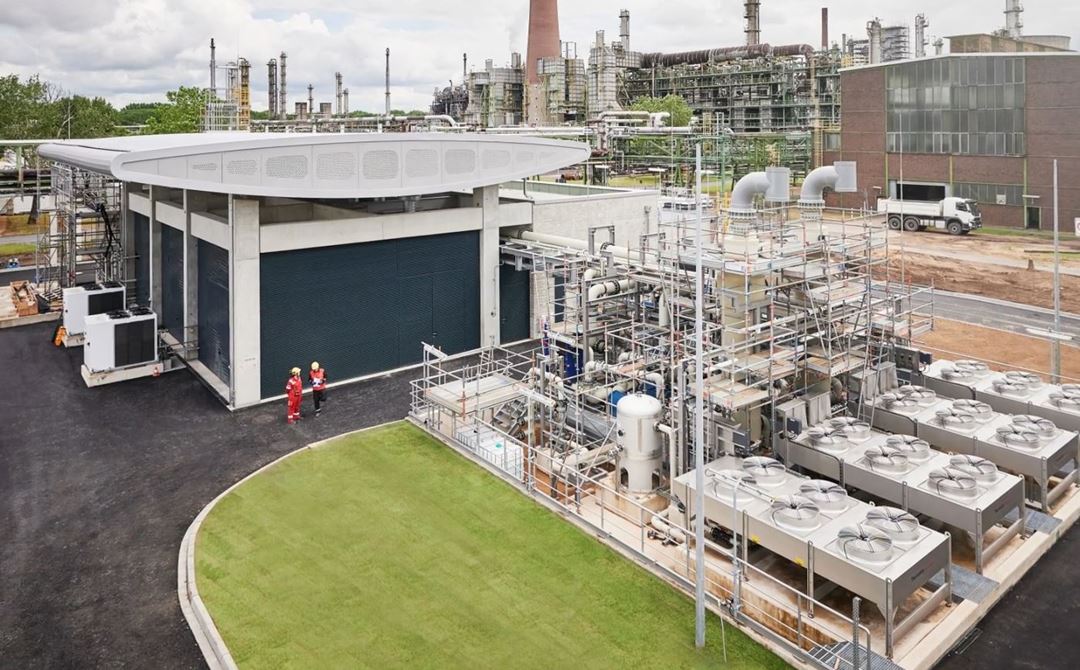Today, the REFHYNE project started the production of green hydrogen from the plant at Shell Energy and Chemicals Park in Rhineland. Shell is taking an important step in establishing Germany's position as a leading country in green hydrogen production and energy system transformation.
The plant - with a capacity of 10 MW – sets the standards for further development in the hydrogen sector and the production of several sustainable chemical - and energy products. The project consists of a European consortium consisting of Shell, ITM Power, SINTEF, Sphera and Element Energy, and is funded by The Fuel Cells and Hydrogen Joint Undertaking (FCH JU).
In REFHYNE's electrolysis modules, water is separated into hydrogen and oxygen using electricity. Green hydrogen has many applications: it can be fed into the refinery network, used in plants to upgrade products or it can be made available to partners at Shell Energy and Chemicals Park Rheinland as a valuable raw material.
The hydrogen is also planned to be used as fuel in transport, for heating purposes and as energy storage for renewable energy. REFHYNE I will produce up to 1300 tonnes of hydrogen per year.
Big step towards a carbon-free future
– We are a hydrogen region. With the commissioning of the largest PEM electrolysis plant in Europe, we are further expanding our leading role in this field. We are therefore laying the foundation for a modern and green industry, with highly skilled jobs. Today, 30 percent of German demand for hydrogen already comes from North Rhine-Westphalia's industry. Estimates predict that demand will double by 2030. Therefore, we need innovative solutions that will meet the demand for CO2-neutral hydrogen. Projects such as Refhyne demonstrate how innovation can benefit both the environment and the economy, said Armin Laschet, North Rhine-Westphalia’s Minister-President.
– We want to become a leading supplier of green hydrogen for industrial and transport customers in Germany. Therefore, we have an eye on the entire value chain: from power production through offshore wind to an expanded production and distribution in all sectors. We want to be a competent and reliable supplier and the prefered partner for decarbonisation, said Huibert Vigeveno, board member of Royal Dutch Shell.
– In order to achieve climate neutrality by 2050, we need to fundamentally reshape our energy system. Clean hydrogen will play a key role in e-mobility and in industry, as it has great potential for decarbonising sectors where direct use of renewable energy is not possible. Accordingly, we want to accelerate the market launch of fuel cells and hydrogen technology and tap into their advantages in Europe, says Bart Biebuyck, CEO, FCH JU.
– This is a big step towards a carbon-free future. SINTEF has been heavily involved in European electrolysis research for more than a decade, from fundamental development of materials and components to pilot projects. We are happy to see large-scale implementation as here in REFHYNE. The green transition was something we talked about, now it is what we do. The transformation to the low-emission society is happening now and it is scaling up, says Alexandra Bech Gjørv, CEO of SINTEF.
– REFHYNE is standing on the shoulders of approximately 30 EU-supported projects on the production of green hydrogen in which we at SINTEF have participated. Today we celebrate a major milestone that will hopefully accelerate Norway's efforts. We already have strong industrial traditions and companies that uphold themselves in global competition in several parts of the value chain, world-class research and renewable energy, so all of the success criteria are present, says SINTEF's marketing director for hydrogen and board member of Hydrogen Europe Research Steffen Møller-Holst.
– Hydrogen will play an important role in the energy system of the future by enabling decarbonisation of large parts of the transport sector and several industrial processes. As the EU's hydrogen strategy points out, we will have to have many electrolysis plants on a large scale to be able to meet the demand that the green transition in these sectors will create. This project will set the standard for how these facilities will be built, says senior project manager in SINTEF and coordinator for REFHYNE Anders Ødegård.
The construction of plants with 100 MW capacity starts in 2022
Shell is already planning to build an electrolysis plant with ten times the capacity - "REFHYNE II", together with ITM Power, ITM Linde Electrolysis GmbH og Linde and other European partners (SINTEF, Element Energy, Tecnalia and CONCAWE). The application for support for the project from the European Green Deal was ranked at the top, and the consortium is currently working on concluding the grant contract with the European Climate, Infrastructure and Environmental Executive Agency (CINEA).
Construction of this facility can start as early as next year. REFHYNE II will build and test a 100 MW PEM electrolyser at one of Shell's refineries in Cologne, Germany. This plant is scheduled to be operational in 2024 and will be the largest of its kind, with a production of up to 15,000 tonnes of hydrogen per year. The goal is to produce hydrogen at less than 3 euros per kilo, which corresponds to less than half the cost of taxed diesel for transport.
– This project demonstrates a new type of energy future and a model for low-emission energy production that can be recreated worldwide, said Shell's downstream director Huibert Vigeveno at today's official opening ceremony.
Facts about REFHYNE
- REFHYNE is Europe's largest PEM electrolysis plant with a capacity of 10 Megawatt (MW) and started its production of green hydrogen in Shell Energy and Chemicals Park in the Rhineland today.
- The REFHYNE project is at the forefront of the work of producing green hydrogen in Europe. Hydrogen will play a key role in the European Green Deal's climate goals by helping to decarbonise sectors such as transport and industry, which the European Commission's hydrogen strategy from 2020 has aimed for. The EU's goal is to have at least 40 GW of electrolysers in operation by 2030.
- The REFHYNE consortium consists of Shell, ITM Power, SINTEF, Sphera and Element Energy.
- Through the REFHYNE II project, the capacity will be increased tenfold to 100 MW. The consortium has been successful in its application to "Develop and demonstrate a 100 MW electrolyzer upscaling the link between renewables and commercial / industrial applications" within the European Green Deal program to the EU and is now invited to prepare the associated grant contract with CINEA*
- SINTEF, with senior project manager Anders Ødegård in lead, is the coordinator for both REFHYNE I and REFHYNE II.
*The invitation to the grant agreement preparation should not be regarded under any circumstances as a formal commitment by CINEA to provide financial support, as this depends on the satisfactory and timely conclusion of grant agreement preparation.


